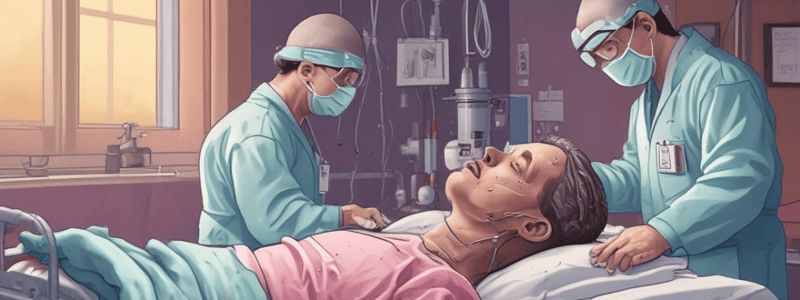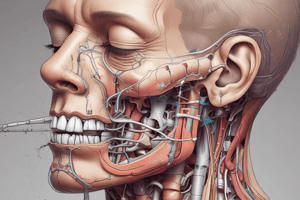Podcast
Questions and Answers
The pediatric thorax is more susceptible to fractures due to calcification and osteoporosis.
The pediatric thorax is more susceptible to fractures due to calcification and osteoporosis.
False (B)
Acceleration-deceleration injuries can cause shearing, tearing, and traction forces on fixed structures such as the aorta.
Acceleration-deceleration injuries can cause shearing, tearing, and traction forces on fixed structures such as the aorta.
True (A)
Flail chest is a type of open pneumothorax.
Flail chest is a type of open pneumothorax.
False (B)
Traumatic rib fractures are often associated with lung contusion.
Traumatic rib fractures are often associated with lung contusion.
Sternal fractures are common and occur in up to 50% of chest trauma cases.
Sternal fractures are common and occur in up to 50% of chest trauma cases.
Tracheobronchial tree injuries require immediate surgical intervention in case of unstable airway.
Tracheobronchial tree injuries require immediate surgical intervention in case of unstable airway.
Haemothorax is always associated with a flail chest.
Haemothorax is always associated with a flail chest.
Primary repair is a management option for tracheobronchial injuries.
Primary repair is a management option for tracheobronchial injuries.
The primary survey in the initial evaluation of chest trauma involves a detailed physical examination.
The primary survey in the initial evaluation of chest trauma involves a detailed physical examination.
Foreign bodies in the airway are always chronic.
Foreign bodies in the airway are always chronic.
The goal of the initial evaluation of chest trauma is to identify and manage all injuries, including non-life-threatening ones.
The goal of the initial evaluation of chest trauma is to identify and manage all injuries, including non-life-threatening ones.
Cervical esophageal injuries are the most common type of esophageal injuries.
Cervical esophageal injuries are the most common type of esophageal injuries.
A chest X-ray is not a useful investigation for esophageal injuries.
A chest X-ray is not a useful investigation for esophageal injuries.
Diaphragmatic injuries are always diagnosed immediately.
Diaphragmatic injuries are always diagnosed immediately.
Blunt cardiac injuries always result in rupture of the myocardium.
Blunt cardiac injuries always result in rupture of the myocardium.
All esophageal injuries require immediate surgical repair.
All esophageal injuries require immediate surgical repair.
Tracheobronchial injuries can be managed with lung resection.
Tracheobronchial injuries can be managed with lung resection.
Foreign bodies in the esophagus are always chronic.
Foreign bodies in the esophagus are always chronic.
The mortality rate of blunt aortic injuries is 50% within 6 hours.
The mortality rate of blunt aortic injuries is 50% within 6 hours.
Myocardial contusion is reported in 40% of autopsy series of patients with BCI.
Myocardial contusion is reported in 40% of autopsy series of patients with BCI.
Elective surgery is preferred for myocardial rupture.
Elective surgery is preferred for myocardial rupture.
The most common site of blunt aortic injuries is the aortic arch.
The most common site of blunt aortic injuries is the aortic arch.
A widened mediastinum is a radiographic feature associated with thoracic aortic injury.
A widened mediastinum is a radiographic feature associated with thoracic aortic injury.
Endovascular stents are a type of open surgical procedure for blunt aortic injuries.
Endovascular stents are a type of open surgical procedure for blunt aortic injuries.
Tricuspid valve repair is recommended for penetrating cardiac injuries.
Tricuspid valve repair is recommended for penetrating cardiac injuries.
Aortic disruption is typically managed with conservative therapy.
Aortic disruption is typically managed with conservative therapy.
Flashcards are hidden until you start studying
Study Notes
Tracheobronchial Tree Injuries
- Conservative treatment for tracheobronchial tree injuries
- Surgical approach based on location and extension of injury
- Cervical collar incision for proximal trachea
- Right postero-lateral thoracotomy for lower trachea, carina, right main bronchus (RMB), and proximal left main bronchus (LMB)
- Left postero-lateral thoracotomy for distal LMB
- Management options: primary repair, sleeve resection, lung resection
Foreign Body in the Airway
- Management of foreign body in the airway:
- Acute: urgent bronchoscopy with or without bronchotomy
- Chronic: bronchoscopy with precaution, with or without lung resection
Esophagus Injuries
- Esophagus injuries are rare, often caused by blunt trauma or penetrating injuries (stab or trans-mediastinal gunshot)
- Cervical esophageal injuries are most common
- Clinical features:
- Pneumothorax (left)
- Haemothorax without rib fractures
- Lower sternum or epigastric pain (severe blunt trauma)
- Particulate matter in the ICD
- Penetrating injury that has crossed mediastinum
- Odynophagia
- Dysphagia
- Surgical emphysema
- Mediastinitis
- Investigations: combination of clinical suspicion, CXR, water-soluble contrast swallow, and oesophagoscopy
- Management:
- Timing: 24 hours, debride and drainage, surgical repair or resection with delayed reconstruction
- Approach: via right posterolateral thoracotomy (RPLT) for upper esophagus, or left posterolateral thoracotomy (LPLT) for lower esophagus
- Complications: mediastinal contamination, abscess formation, empyema thoracis
Foreign Body in the Esophagus
- Types of foreign bodies: bone, meat, battery, coin
- Clinical presentation:
- Acute: dysphagia, choking, hematemesis
- Chronic: hemoptysis, coughing when feeding
- Management: oesophagoscopy with or without mediastinal drainage and repair
Diaphragmatic Injuries
- Often occult, easily missed, and commonly detected on the left side
- Marker of severe thoracoabdominal trauma
- Causes: blunt, penetrating (stab or iatrogenic-ICD)
- Clinical features:
- With or without signs of bowel obstruction, drainage of peritoneal content via chest drain
- NGT in the chest (CXR)
- Herniation of GIT
- Acute, delayed, and common on the left side
- Investigations: CXR (elevated hemidiaphragm, haemo-pneumo), swallow and follow-through, contrast-enhanced CT scan
- Management: surgical repair via thoracotomy, thoraco-abdominal incision, or laparotomy, laparoscopy
Cardiac Injuries
- Penetrating and blunt cardiac injuries
- Blunt cardiac injuries (BCI):
- Pathology: patchy areas of muscle necrosis, hemorrhagic infiltrate, rupture of small vessels, hemorrhage into interstitium and around muscle fibers
- R.Madansein, Department of Cardiothoracic Surgery, UKZN
- Frequency of Injury: 20-25% of thoracic deaths worldwide
- Male vs female, age, blunt, penetrating, and transfixing mechanisms
Thoracic Trauma
- Thoracic injury accounts for 20-25% of thoracic deaths worldwide
- Mechanism of injury:
- Penetrating: high velocity (gunshots), low velocity (stab wounds)
- Blunt: direct (assault and blast), indirect (falls, MVA - acceleration-deceleration injuries, crush injuries, and shearing forces)
- Transfixing
- Special factors: pediatric thorax (more cartilage, absorbs forces), geriatric thorax (calcification and osteoporosis, more fractures)
Studying That Suits You
Use AI to generate personalized quizzes and flashcards to suit your learning preferences.




